Today we will take a closer look at the main types of circular saws. Let's define reasonable criteria for choosing a particular model. We will draw conclusions for recommendations based on the experience of practicing builders and employees of service centers. Join.
Electric circular saw (popularly "circular", "parquet") appeared in the twenties of the last century. As usual, several "organizations" have worked hard. At first, a radial-cantilever type of wood cutting machine was developed (Raymond DeWalt), a little later, manual models began to be produced under the Skilsaw brand (Salivan and Mitchell). There were also separate patents for saws with side and integrated drive in the name of A. Emmons and A. Steele, respectively. Well, the AEG company helped to “ground” the invention and promote it to the masses, whose engineers were the first to connect the instrument to a common 220 volt network. Nowadays, the circular saw has reached perfection, the set of options and auxiliary systems for it has not changed for a very long time, not to mention the design features. It's just that everyone is slowly moving towards the premium class.
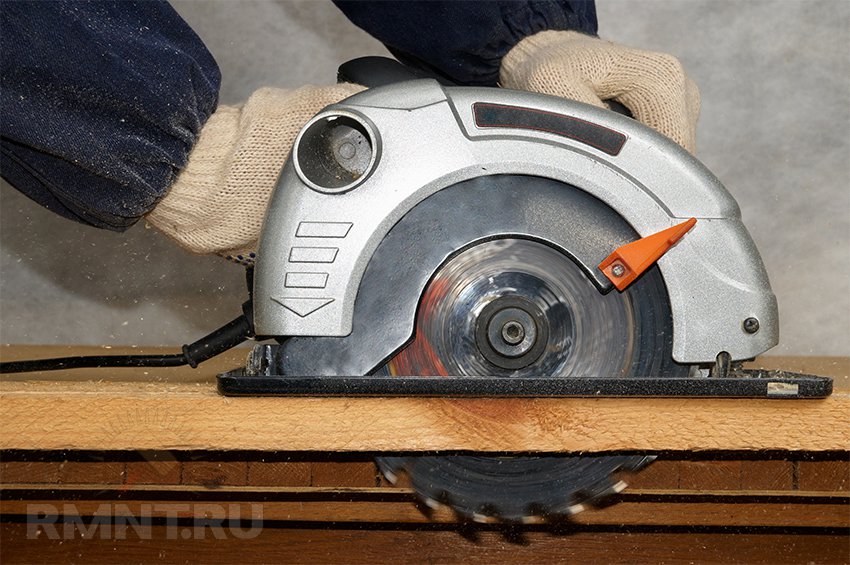
The circular is considered one of the most technically complex instruments, and that's not even considering that it can have a full set of electronic bells and whistles available. The fact is that here it is necessary to constructively provide unprecedented security measures (like all disk machines, “parquet floors” can be very traumatic), as well as to realize the high accuracy of many spatial mechanical settings. Self-repair of a circular is considered to be a risky undertaking due to the difficulty of restoring the correct factory settings.
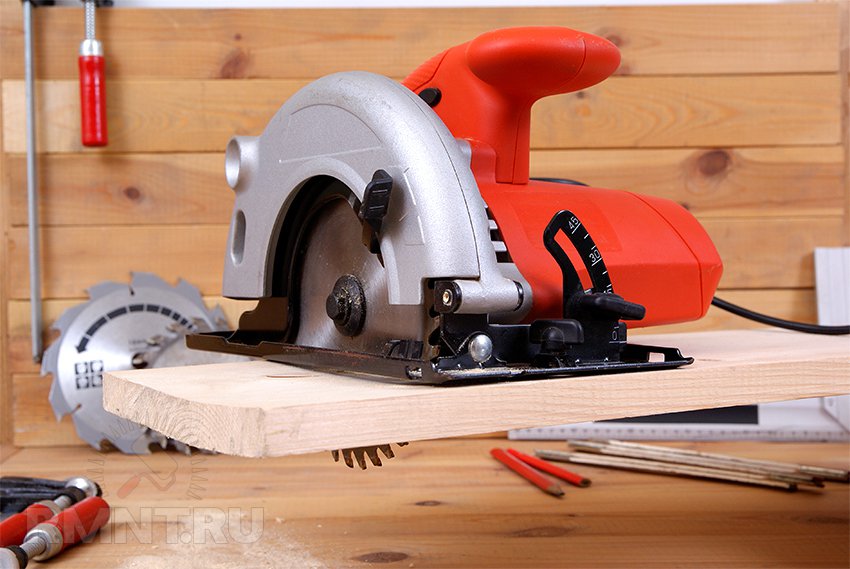
The main purpose of the circular saw is to perform longitudinal cutting of wood and its derivatives (OSB, chipboard, fiberboard, MDF, plywood), because this tool holds the line perfectly, the jigsaw cannot be compared here. Naturally, cross cutting for a circular saw will also not be a problem. But it would be strange if a modern cutting unit would not be sharpened to work on other materials. Indeed, using various types of discs, and in some cases changing the shaft speed, it is possible to cut laminated workpieces, GVL, plastic of various densities, multilayer materials (sandwiches), slate, plexiglass. In a word, almost all sheet panels are perfectly cut, including at an angle to the main plane. The only thing that the circular is too tough for is dense mineral materials (concrete, brick, plaster). True, some units can be equipped with a diamond blade and have a water supply; structurally, these are full-fledged circulars (Makita 4101RH). There is still one iron “but” - a circular saw cannot cut along a curved line.
What is a metal circular
Separately, it is worth highlighting circular saws for working on metal. Although they are positioned in the market in this way, they are essentially multifunctional. It's more about the characteristics of the standard wheel, which comes as standard (this is not an abrasive, it is a hard-alloy toothed multi-purpose disk). Such units easily deal with pipes, tin, complex profiles, sheet steel and stainless steel (Makita 4131). The conversation is very simple with both steel and soft non-ferrous alloys (based on copper, aluminum).
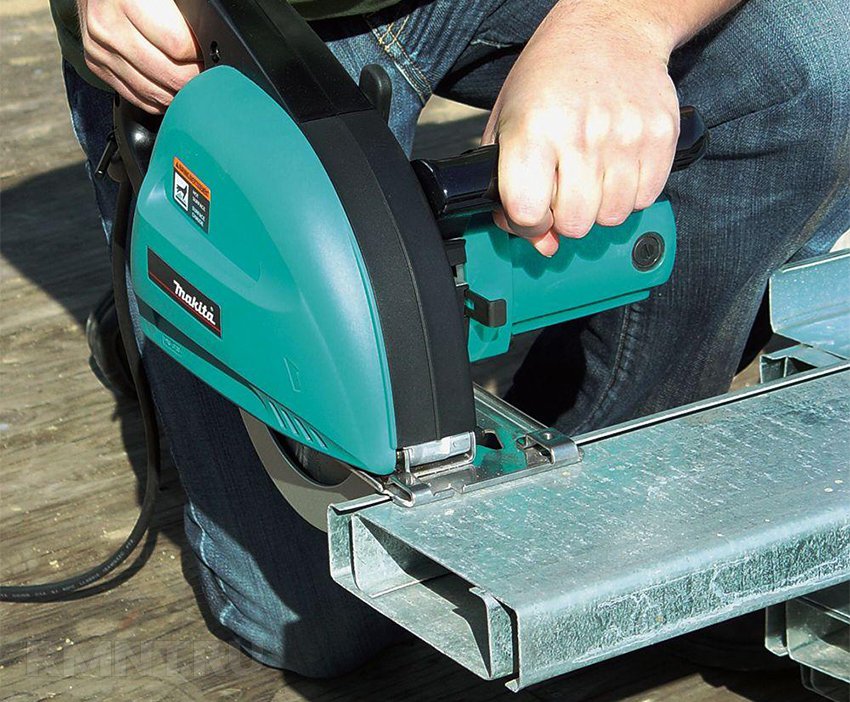
But what about USM? Compared with grinders, equipped with a cutting wheel, we have the following:
- Productivity is much higher.
- The operator is unloaded as the machine rests on the sole.
- The level of noise and vibration is reduced.
- Work "on a bevel" is possible.
- There are no sparks, the workpiece almost does not heat up and does not “burn out”.
- Improved security (rigging is almost completely hidden and not subject to tearing).
- The resource of a carbide disc is about 100 times higher than that of an abrasive.
- The cut price is the lowest (only the guillotine is cheaper and faster).
- There is no release of mineral dust into the air, as from stone equipment.
- The cut is very high quality, without burrs.
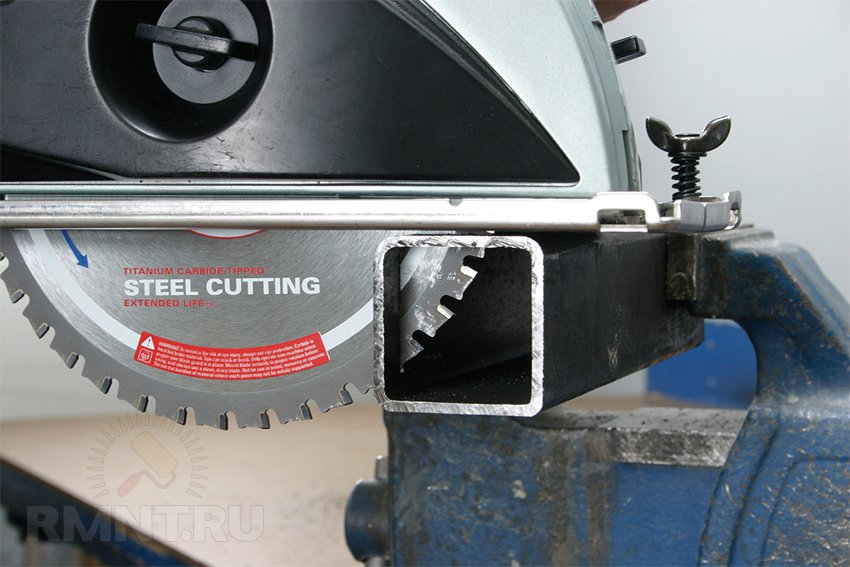
Our masters have just tried this device, and in Europe and the USA such machines are in full use, quite naturally, with such and such pluses. For example, the EVOLUTION 230 XTREME cuts sheet steel (class A-3) with a thickness of 12 mm, profiles / pipes with a wall of 4 mm, and, of course, everything else (wood, polymers).
Plunge circular saw
Another class of circulars is a plunge-cut saw. It is designed to plunge into the workpiece anywhere, not just from the edge. Here, the lower automatic casing is completely absent, and the disc is located above the base plate and lowers only when the “start” button is pressed. Naturally, the cutting depth is adjustable, and often within a range of a few millimeters (DWS520K).

A submersible mechanism (something similar is implemented in wall chasers) allows you to make local repairs to the roof, dismantle several selective floorboards, and cut an opening in the countertop. Without much difficulty, you can make grooves, slots, gutters. For correct work with sandwiches and laminated materials, the top layer can be cut with a preliminary pass to an incomplete depth of the workpiece, thereby eliminating the risk of chipping. All this is done not only perpendicular to the plane of the part, but also under a variable slope.
Cordless circular saw
More recently, such units seemed to us a real fantasy. But as time goes by, wireless technology is reaching a new level. Batteries have become so capacious, special motors have become so economical, and chargers have become so fast that even for such a powerful tool as a circular, the developers managed to organize an uninterrupted power supply. We take two modern batteries and a half-hour charge - that's it, there will be no problems with energy (Makita BSS 610 RFE). It's even easier if your circular saw is equipped with a standardized battery from the same manufacturer as the rest of your tools. The power characteristics (output power, torque) of wireless circulars are no longer inferior to those of similar network machines - Bosch GKS 18 V-Li (cutting depth 51 mm). Well, as for mobility and ergonomics, then here they are beyond any competition, they are especially loved by roofing operatives working at height.
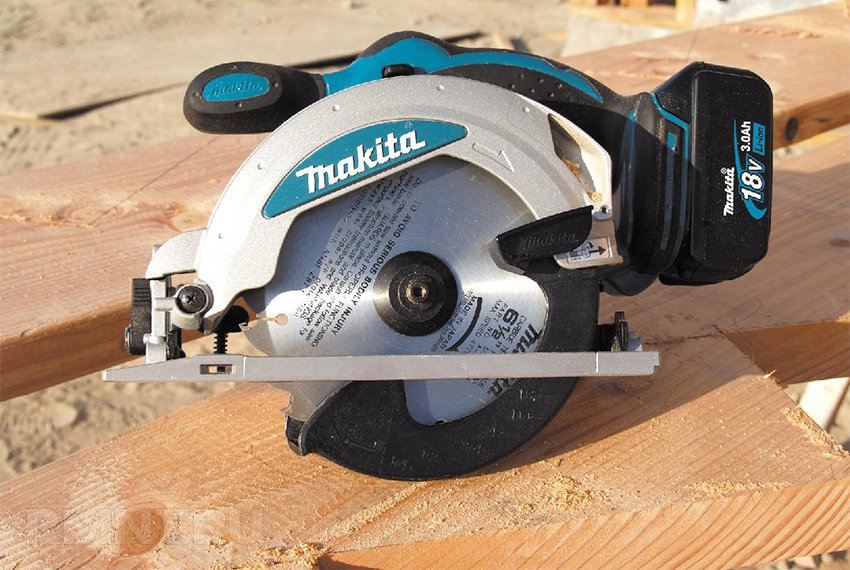
Main selection criteria
Power, speed, blade diameter, cutting depth
The diameter of the cutting disc (outer, not the size of the mounting hole) - it can be said without exaggeration that this is the main parameter of the circular. Based on it, manufacturers are forced to assemble a specific model. The larger the disk, the more powerful the motor must be in order to spin it up to the desired speed, the more torque is required to maintain this speed and there is no jamming, the more technologically advanced the stabilization system should be, so that there is no beating, vibration and noise, the harder , larger, the saw will be more expensive. But on the other hand, large equipment allows you to cut more massive workpieces, material of greater thickness.
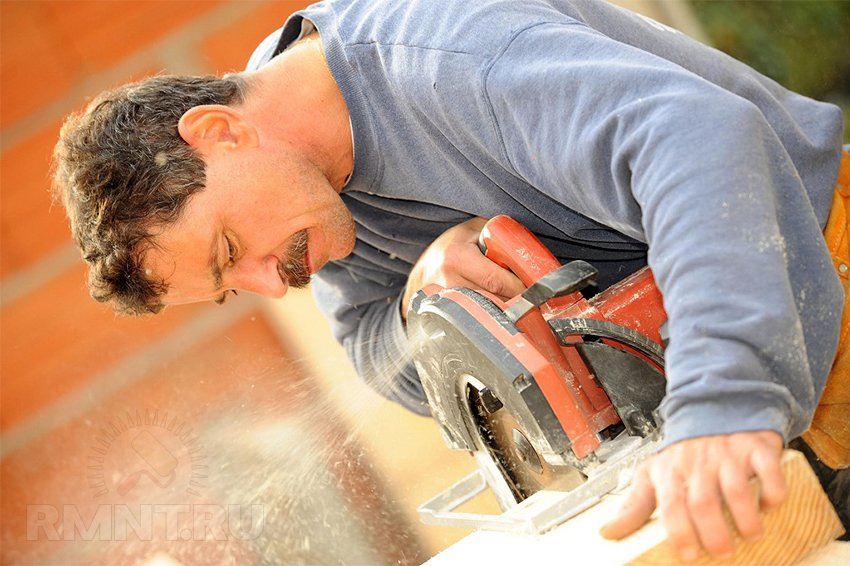
However, it is not enough just to pay attention to the size of the circle, it is much more important to have an accurate idea of \u200b\u200bthe maximum depth of cut. Developers almost always indicate these parameters in passports, both for perpendicular and beveled cuts. There is some conditional division:
- Light class (40-50 mm) - sheet materials, work "in place".
- The middle class (50-65 mm) is the most common, universal.
- The heavy class (65-140 mm) are massive, purely professional machines.
The conventionality is that many companies issue their own special classification (Makitovites, for example, do not let out babies at all and move a little forward in this matter). It turns out that we, ordinary users, can only listen to our needs, choose a priority in the ratio of "maneuverability / versatility / strength", based on the specifics of the intended work. For example, Hitachi C13U (weight 13 kg, disk 335 mm, 2000 watts) and Hitachi C6MFA (weight 3.4 kg, disk 165 mm, 1010 watts). The straight cut depth ratio for these models is 128 mm to 57 mm respectively.
 Left: Hitachi C13U, Right: Hitachi C6MFA
Left: Hitachi C13U, Right: Hitachi C6MFA
I would also like to note that in case of emergency, you can cut a very voluminous part by making a cut on both sides (yes, for correct operation, the disk does not have to pass through the workpiece through and through).
What else gives power reserve? If there is a need to compare two circulars with the same depth, then a stronger motor of one of them will provide better frequency stability, longer continuous operation time, and will allow faster cutting of denser material. Watts under the hood are traditionally correlated with the diameter of the equipment and, again conditionally, the units are credited to one of the three corresponding classes:
- Up to 800W.
- From 800 to 1200 watts.
- More than 1200 W (for example, Hitachi C9U2 - 2 kW, Makita 5143R - 2.2 kW).
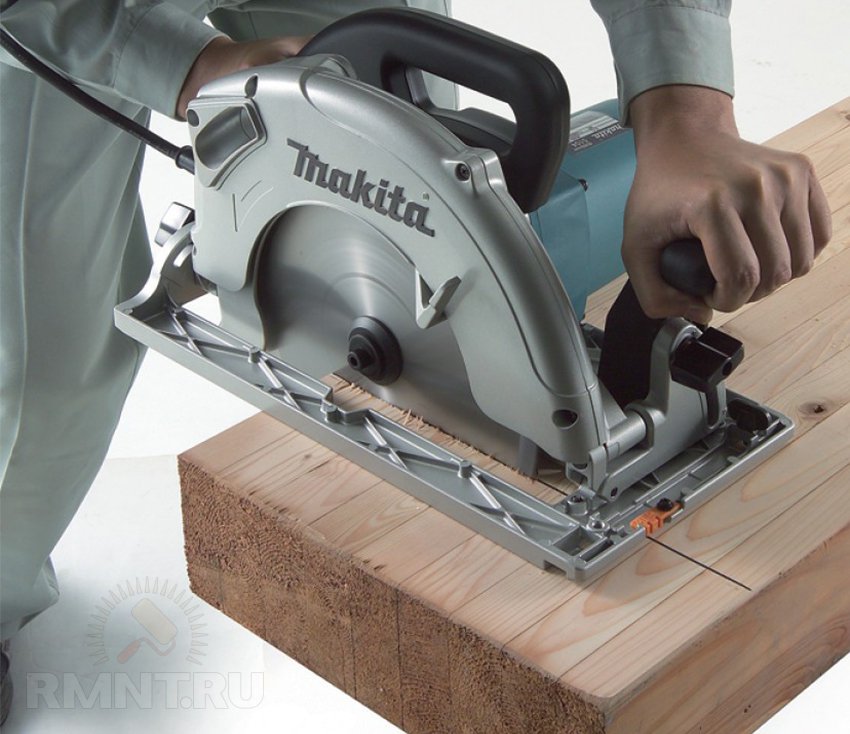
The speed of rotation of the disk - what does it give, besides the speed itself? There are two main nuances. First, the faster the shaft moves, the cleaner the cut is (although the purity depends more on the type of disc - the number and shape of the teeth). Second, high speed is the opposite of torque. Thirdly, high speed is high temperature, and some plastics may start to melt during sawing. If the frequency has become a stumbling block (read "choice"), then you need to compare saws with the same diameter of the cutting disc. Even better, find a model with adjustable idle speed.
Electronics on guard
Advanced circulars are stuffed with electronic systems to the eyeballs. This is quite predictable, since this tool is powerful and dangerous - the user needs help so that the mission is not impossible. If there is a financial opportunity, you should not give up additional options; there are no unnecessary trifles for performance and safety.
For the benefit of the correct speed mode, a system for maintaining a constant spindle speed under load, the so-called constant electronics (DeWalt DWS520K), is working. A special controller constantly reads the speed and in case of a local drop in speed (for example, when the feed is accelerated or when the equipment hits a compacted area of the material), it is stabilized by an automatic increase in outgoing power. The probability of disc jamming is reduced to almost zero, but the quality of the cut is only improving. Obviously, this requires a certain power reserve (this is the prerogative of relatively large machines). Another point is the idle speed adjustment, presetting. It is needed for manual selection of process parameters for materials with different physical characteristics (Metabo KSE 68 Plus). Not all models can boast of such an option. And, by the way, the possibility of presetting is not a prerequisite for the presence of constant electronics; the only available frequency can also stabilize.

In order not to overload the network when the tool is turned on, since the starting currents, albeit in a short period of time, significantly exceed their nominal value, almost all more or less powerful circulars have a soft start system. The equipment does not accelerate immediately, which eliminates the jerk of the tool and saves the parts of the gearbox from unnecessary shock loads, the unit lives much longer (Fiolent PD 3-70E).
If the operator is in a hurry to complete what he has started and does not listen to the “well-being” of the saw blade, then the overload protection system will receive a signal from overheated motor windings or react to a sharp drop in power consumption and turn off the power, while maintaining the performance of an expensive tool.
The electrodynamic brake stops the disc abruptly after the start key is released (AEG BKS 18). The system is designed to protect the operator from possible injury, the part from damage, and the machine from kickback.
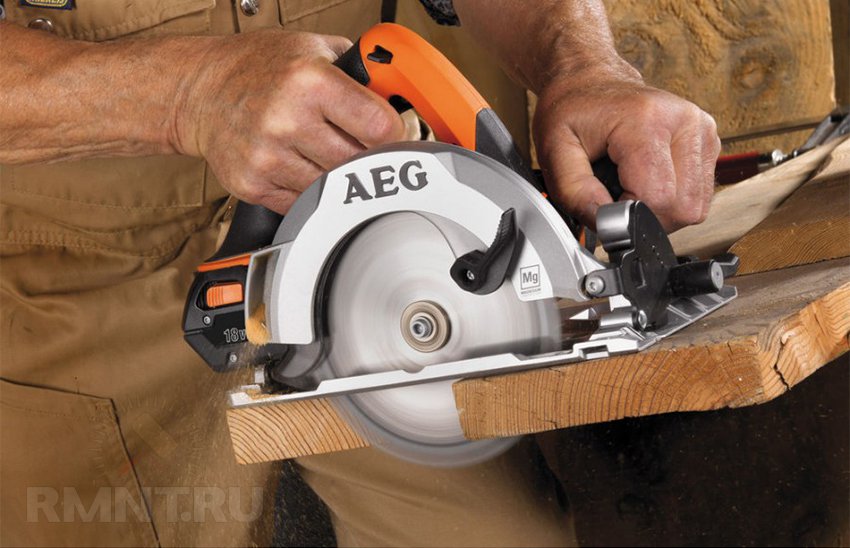
Mechanical Features
With a dull jamming of the equipment, the motor can fail very quickly, there is a possibility of a kickback. To protect against such a nuisance, a slip clutch is used. The working shaft of the motor will continue to rotate even when the disk is stationary. Do not worry, the system does not work unnecessarily.
Protection against accidental activation is implemented by installing an additional button in the area of the main handle. To apply power to the motor, it must be pressed simultaneously with the start key (Skil 5064AA). To make such a chord unintentionally, perhaps, is impossible at all, especially since the "fuse" is usually recessed into the plastic. Often (for other instruments) this button allows you to fix the trigger on, this will not work here - the toothed disk should always be under control.
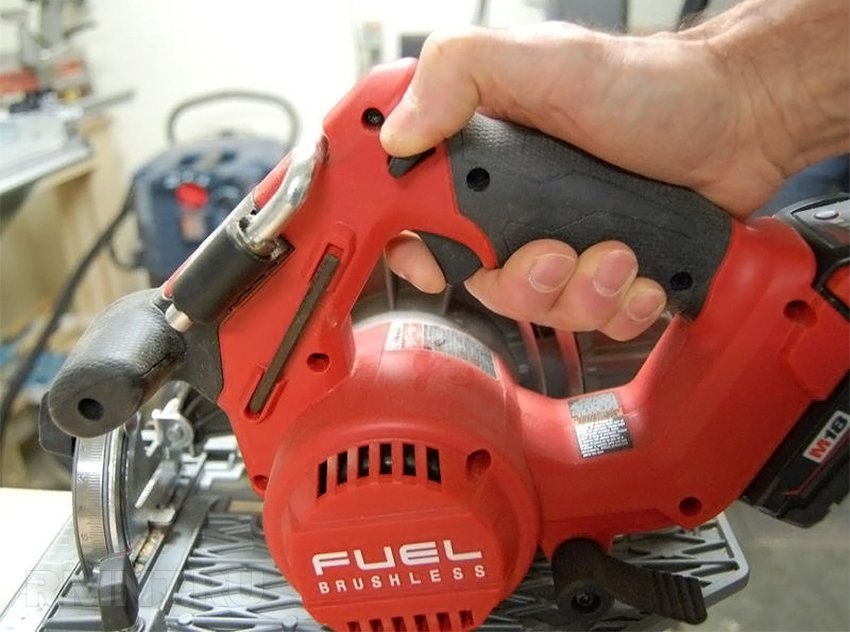
For the convenience of replacing the disc, the spindle can be locked with a button or lever, in some models literally in any position (no need to scroll to look for a setting point - Bosch GKS 65 CE Professional). If there is no lock, you have to wield two keys at once. The nut itself can be tightened with a wrench / screwdriver, or it is performed in a “toolless” version - quick-clamping.
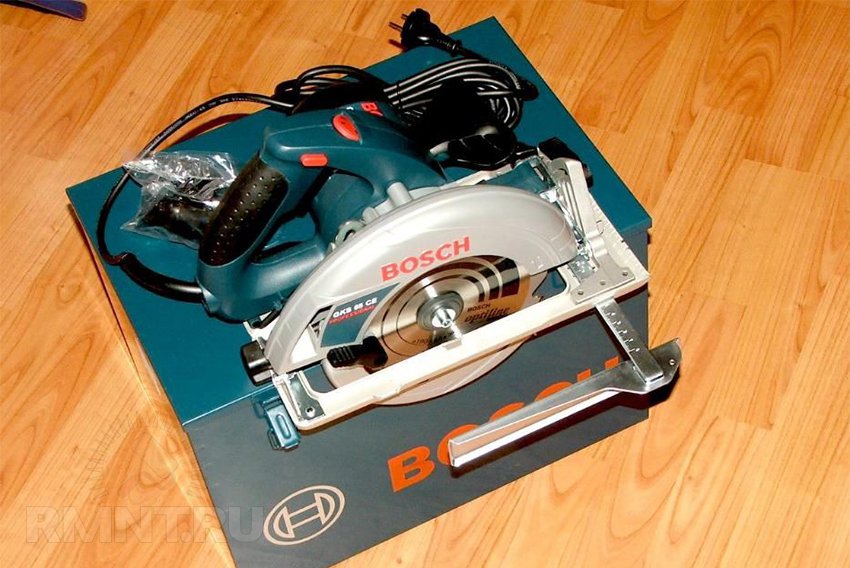
A lot of the functionality of the circular depends on its base plate. Note that it is on it that all mechanical adjustments and fastenings for auxiliary elements are installed. Traditionally, platforms made by casting light alloys are considered to be of higher quality. They clearly indicate the professional class of the instrument, as they retain their geometry well (Interskol DP-235/2000M). However, thick stamped steel pads should not be discounted. They are more resistant to impact loads (they do not crack from accidental impact), affect the price of the product to a lesser extent, and are also used in professional tools (Bosch GKS 65 CE Professional).
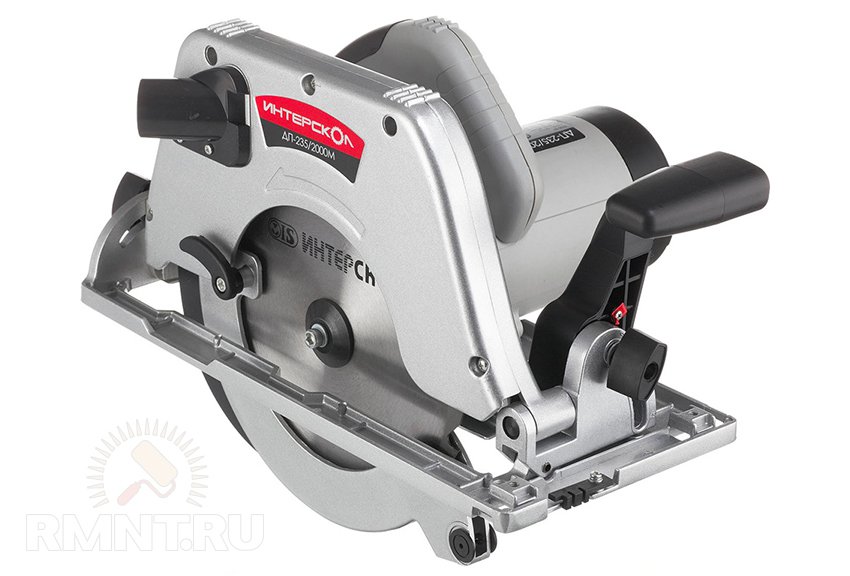 Interskol DP-235/2000M
Interskol DP-235/2000M
An important point is the adjustment of the bevel cut. Sawing at an angle is realized precisely by changing the position of the platform relative to the entire upper part and the disk in particular. Usually the slope is set at different angles: 30°, 45°, and in some machines it is extended to 50-55°. There is also a mechanism for setting the depth of cut. As a rule, this is all done in the form of grooves shaped like a quarter of a circle (in some cases graduated) and rods with wing/lever clamps. The main advantage of quality control elements is the speed, reliability and accuracy of fixation (Kress 1400 HKS). Backlash here is extremely unwanted guests.
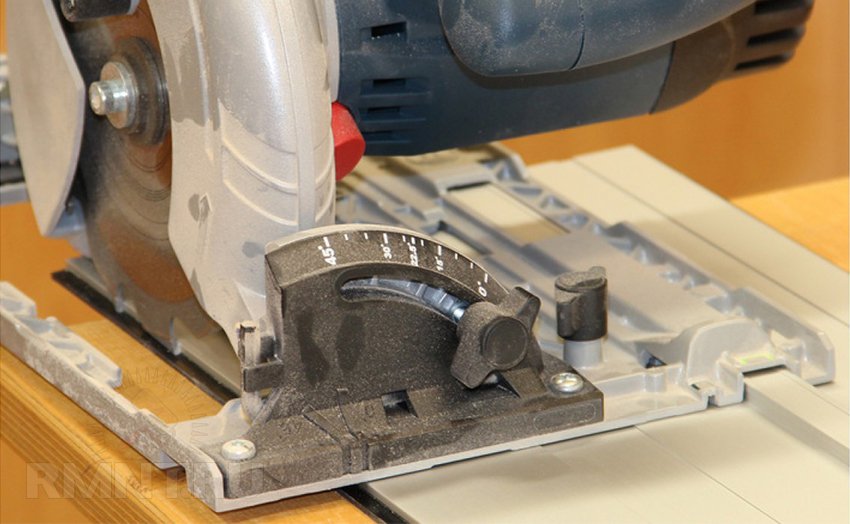
Another advantage of the thoughtful platform is the ability to install the saw in a stationary position. This refers to the option of creating a machine without using a special table. This moment will be relevant for all machines, but even more so for especially powerful and heavy ones.
To perform a high-quality straight cut, circular saws are already equipped with a parallel stop in the basic configuration, by the way, it can also be light-alloy. However, the greatest accuracy of sawing work can be achieved using a guide bar. The tire is bought separately (they often fit from other manufacturers), but the sole must have a special groove. If you need to work "by hand" on the markup, you need to control the line; for this, a special slot is made in front of the base plate. An interesting option is implemented in the EVOLUTION 180 XTREME saw, where a laser line builder is built into the handle, during operation you only need to combine it with the markings.
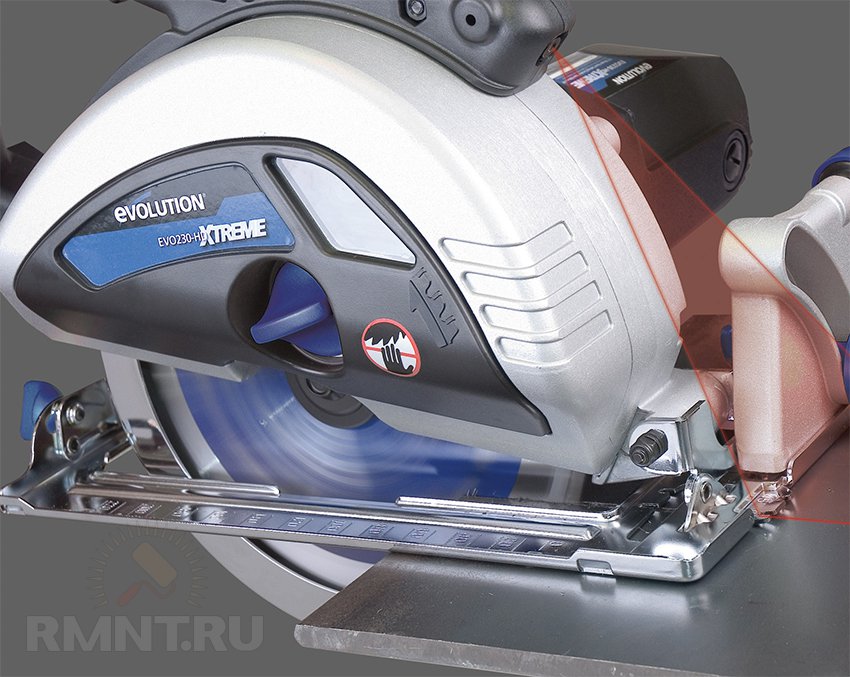
A mandatory accessory for a circular saw is a spring-loaded casing that completely hides the disc, releasing it only at the start of sawing (you need an emphasis on the workpiece). The cover should move easily and always return to its original position. To prevent the disk from being squeezed from the sides by already cut material and not to stop, a “riving knife” is used in the design.
Ergonomics and more
The circular is a manual tool, so when choosing, special attention should be paid to the overall ergonomics of the product. Interestingly, some manufacturers even produce a tool for left-handers, with a mirror layout.
The most important role in the comfort of any circular is given to the shape and location of the handles. Obviously, each user will have their own requirements. Most of the questions are raised by the front handle, which is most often straight, located perpendicular to the plane of motion of the saw blade. This design is good if you work forward, but most often the tool is carried from the side - so most craftsmen prefer the mushroom version, which is easily held in any position (DeWalt D23620). For some, a bracket-like design (DeWalt D23650K) may be more suitable.
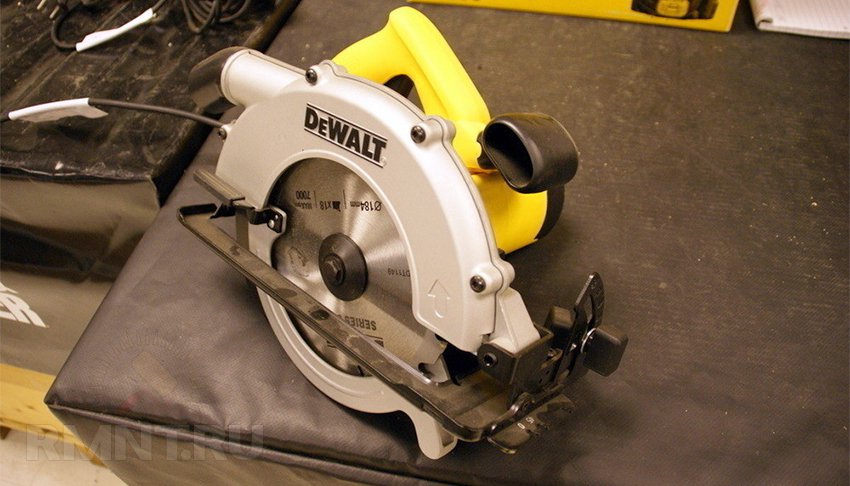
Give preference to models with rubberized handles, they help to securely hold and control the tool during operation.
It will not be superfluous to hold several circulars in your hands before buying, most likely, a lot will become clear to you regarding the weight distribution of specific machines and their balance. Be sure to do this if you plan to do a lot of work "in place".
Evaluate the visibility of the working area, the specific design features of the circular saw very seriously affect this circumstance. It is also important how efficiently sawdust is removed from the disc. Here, surface air is used (directed away from the operator), a branch pipe is integrated for connecting an industrial vacuum cleaner and connecting a bag. There are options with a dust container.
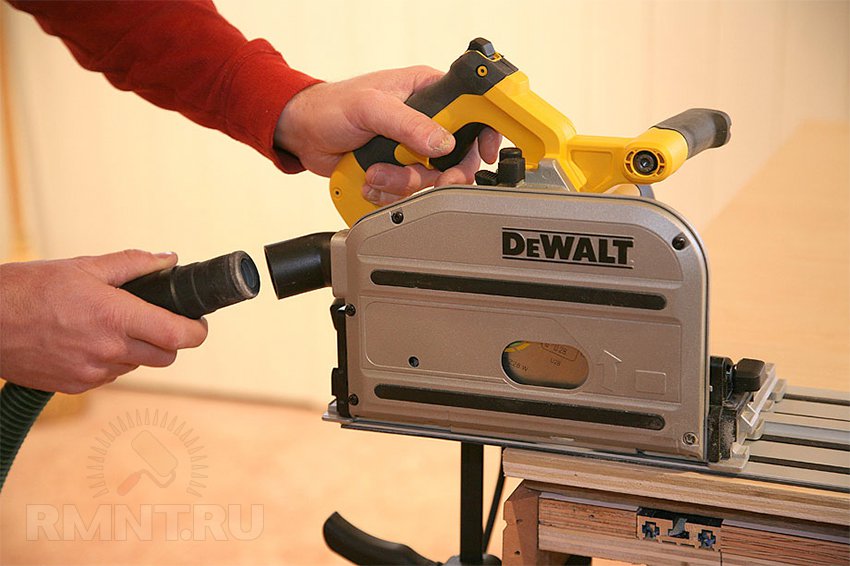
Take a look at how the entry point to the power cord tool is executed. Unfortunately, users very often cut the supply cable, so it is better if it is directed strictly backwards, and the input sleeve is as long and rigid as possible. Maximum freedom and safety will be given by a long power cord - 4 meters is no longer a rarity for professional models. Otherwise, you will have to regularly deal with the extension block.
Sooner or later, a circular saw will require replacement of the carbon brushes, otherwise the motor armature is in jeopardy. Therefore, it makes sense to “monitor” this node as well. Well, if there is a separate window for quick access to the brushes, then you don’t have to disassemble the case, or go to the service for this if the device is under warranty. A great option is self-disconnecting brushes: graphite has worn out - the chain has broken (Sparky TK 70). The next nuance is to indicate the status of the brushes, this is a very useful lotion for a traditional brush assembly.

Most likely, under load you will not be allowed to test the saw, but if the seller allows, plug the saw into the network and run it at idle, listen to the level of noise and vibration. Evaluate how strong the air flow is generated by the tool - this largely determines the efficiency of the motor cooling and the quality of cleaning the working area from debris.
If you plan to work with a circular only from time to time, then pay attention to hobby models from well-known manufacturers (Bosch PKS 55 A, Black & Decker CD601). They are designed for relatively short work (15 minutes work - 15 minutes rest) no more than 4 hours a day. This will be quite enough for home use, and you will be able to save a lot. Ironically, household models often outlive their professional counterparts, and the developers provide them with a double warranty (2-3 years).
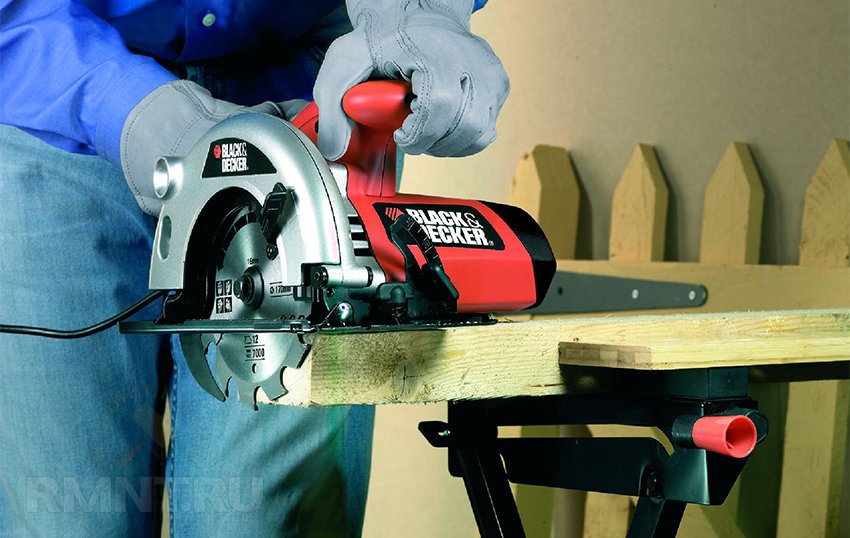
In general, carefully predict the load that the circular saw will receive at your disposal, and based on this, select the characteristics of the model you are looking for. We hope we have given you enough food for thought.